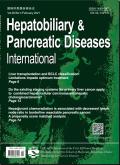Impact of nonalcoholic fatty liver disease on the risk of gallbladder polyps in lean and non-obese individuals: A cohort study
IF 4.4
3区 医学
Q2 GASTROENTEROLOGY & HEPATOLOGY
Hepatobiliary & Pancreatic Diseases International
Pub Date : 2024-12-01
DOI:10.1016/j.hbpd.2024.01.006
引用次数: 0
Abstract
Background
The association between non-obese or lean nonalcoholic fatty liver disease (NAFLD) and gallbladder polyps (GBPs) has not yet been evaluated. We aimed to determine whether NAFLD is an independent risk factor for the development of GBPs, even in non-obese and lean individuals.
Methods
We analyzed a cohort of 331 208 asymptomatic adults who underwent abdominal ultrasonography (US). The risk of GBP development was evaluated according to the obesity and NAFLD status.
Results
The overall prevalence of NAFLD and GBPs ≥ 5 mm was 28.5% and 2.9%, respectively. The prevalence of NAFLD among 160 276 lean, 77 676 overweight and 93 256 obese participants was 8.2%, 31.2%, and 61.1%, respectively. Individuals with NAFLD had a significantly higher incidence of GBPs with a size of ≥ 5 mm [adjusted odds ratio (OR) = 1.18; 95% confidence interval (CI): 1.11–1.25]. A higher body mass index and its categories were also significantly associated with an increased risk of GBPs ≥ 5 mm. Moreover, risk of GBPs ≥ 5 mm was significantly increased even in NAFLD individuals who are not obese (lean: adjusted OR = 1.36, 95% CI: 1.19-1.54; overweight: adjusted OR = 1.14, 95% CI: 1.03–1.26, respectively).
Conclusions
Non-obese/lean NAFLD is an independent risk factor for GBP development, suggesting that NAFLD may play an important role in the pathogenesis of GBPs regardless of the obesity status. Therefore, a more thorough evaluation for GBPs may be necessary when hepatic steatosis is detected on abdominal US, even in non-obese or lean individuals.
非酒精性脂肪肝对瘦人和非肥胖者胆囊息肉风险的影响:一项队列研究
背景尚未评估非肥胖或瘦型非酒精性脂肪肝(NAFLD)与胆囊息肉(GBPs)之间的关系。我们的目的是确定非酒精性脂肪肝是否是胆囊息肉发病的独立风险因素,即使是在非肥胖和瘦弱人群中也是如此。结果NAFLD和GBP≥5 mm的总患病率分别为28.5%和2.9%。在 160 276 名瘦弱、77 676 名超重和 93 256 名肥胖的参与者中,非酒精性脂肪肝的患病率分别为 8.2%、31.2% 和 61.1%。非酒精性脂肪肝患者中,大小≥5 mm的GBP的发病率明显更高[调整后的几率比(OR)=1.18;95%置信区间(CI):1.11-1.25]。较高的体重指数及其类别也与GBP≥5毫米的风险增加显著相关。此外,即使非肥胖的非酒精性脂肪肝患者,GBP ≥ 5 mm 的风险也明显增加(瘦:调整 OR = 1.36,95% CI:1.19-1.54;超重:调整 OR = 1.14,95% CI:1.03-1.26)。因此,当腹部X线检查发现肝脏脂肪变性时,可能需要对GBP进行更全面的评估,即使是非肥胖或瘦人也不例外。
本文章由计算机程序翻译,如有差异,请以英文原文为准。
求助全文
约1分钟内获得全文
求助全文
来源期刊
CiteScore
5.40
自引率
6.10%
发文量
152
审稿时长
3.0 months
期刊介绍:
Hepatobiliary & Pancreatic Diseases International (HBPD INT) (ISSN 1499-3872 / CN 33-1391/R) a bimonthly journal published by First Affiliated Hospital, Zhejiang University School of Medicine, China. It publishes peer-reviewed original papers, reviews and editorials concerned with clinical practice and research in the fields of hepatobiliary and pancreatic diseases. Papers cover the medical, surgical, radiological, pathological, biochemical, physiological and historical aspects of the subject areas under the headings Liver, Biliary, Pancreas, Transplantation, Research, Special Reports, Editorials, Review Articles, Brief Communications, Clinical Summary, Clinical Images and Case Reports. It also deals with the basic sciences and experimental work. The journal is abstracted and indexed in SCI-E, IM/MEDLINE, EMBASE/EM, CA, Scopus, ScienceDirect, etc.

 求助内容:
求助内容: 应助结果提醒方式:
应助结果提醒方式:


